Cliffoney
Cliffoney, officially Cliffony (Irish: Cliafuine (Cliathmhuine), meaning "hurdled thicket"),[2] is a village in north County Sligo, Ireland. It lies on the N15 national route at its junction with the R279. It is only three kilometres away from Mullaghmore which is popular with surfers.
Cliffony Cliafuine | |
|---|---|
Village | |
Cliffony along the N15 road (south side) | |
 Cliffony Location in Ireland | |
| Coordinates: 54.430°N 8.455°W | |
| Country | Ireland |
| Province | Connacht |
| County | County Sligo |
| diocese | Elphin |
| Elevation | 30 m (100 ft) |
| Population (2016)[1] | 492 |
| Irish Grid Reference | G705540 |
Cliffoney has historical connections to Lord Palmerston, British Prime Minister and Father Michael O'Flanagan, Vice-President and later President of Sinn Féin, who was known as the Republican Priest. Brigid MacGonigal, mother of Harry Clarke, was a native of Cliffoney.[3]
There are several megalithic monuments close to the village, including Creevykeel Court Tomb.[4] There are also several ringforts and cashels in the area. Saint Brigit's cross-slab, possibly dating to the eight century, has a swastika carved in the top of the cross.[5]
History
The oldest buildings in Cliffoney are the five megalithic tombs close to the village in the townlands of Creevykeel, Creevymore and Cartronplank. Creevykeel, considered one of the finest examples of its kind in Ireland, was excavated by the Harvard Archaeological Mission in 1935.[4] A second monument close to Creevykeel was destroyed completely by 1890. The chamber and back-stone of Cartronplank court tomb still survives, located on a private farm. The other two monuments are overgrown and on private land.
The Cliffoney megaliths were visited by many antiquarians and researchers, and were illustrated by William Wakeman in 1880.[6] Creevykeel is in state care and is maintained by the Office of Public Works. The other sites are on private property.
Saint Bridget's well and cross
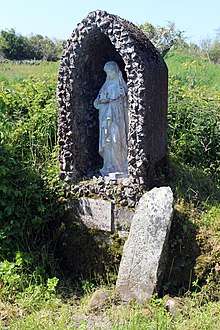
Saint Bridget's well is located on private land close to the village of Cliffoney. The well is located within a large ringfort some 40 meters in diameter which is mostly ploughed out on the south side, but is in good condition on the north side. Beside the well is an early Christian cross slab known as the Cliffoney Cross, thought to date to the eighth century and contemporary with the many carved slabs on Inishmurray. The well was the site of an ancient cattle fair held on 1 February. A shrine with a statue of Saint Bridget was erected in the 1950s.[5]
St Brigid's Well is situated in Mrs Timoney's field about four hundred yards from the main road in the vicinity of Cliffoney. It was called St Brigid's Well, because when she was travelling through Connaught she visited and blessed it.
In its present state it is difficult to locate it, because it is surrounded by briars. In olden days the people used to come from every district and visit it. They used to go round the Well and said the following prayers Our Father and three Hail Marys.[7]
Lord Palmerston
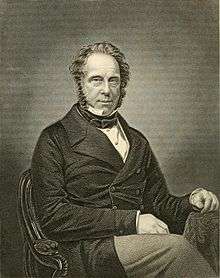
The lands around Cliffoney were granted to James Byrne after the Cromwellian conquests in the mid 1600s.[8] After 1690 the lands were granted to Sir John Temple. The title Viscount Palmerston was created in 1723. The Palmerston family were absentee landlords, leaving the management of their estates to middlemen. The second Viscount "contributed generously to local charities in Romsey, but he had no feelings of obligation towards his Irish tenants, and never invested any money in his lands in Sligo."[9]
Upon the sudden death of the second Viscount in 1802, the Cliffoney estates were inherited by his oldest son, Henry John Temple, better known as the third Viscount, Lord Palmerston.[10] The young Lord Palmerston visited his Sligo estates, consisting of some 10,000 acres, for the first time in 1808.[11]
He found a destitute tenantry renting small plots from middlemen, who set the land to tenants in rundale, a system of communal occupation under which an individual tenant might from time to time hold many tiny detached plots. In the early nineteenth century huge tracts of Ahamlish were destroyed by shifting sands, but Palmerston sought to bring the bogs there, as well as the sands ruined by sand, into cultivation.[12]
Palmerston began a building programme, renovating the old Market House which became a hotel, the Cliffoney Inn in 1820. A boys school was built next door in 1824 and a girls school at the north end of the village in 1826. In further improvements, Alexander Nimmo was engaged to construct a pier in Mullaghmore. While Nimmo was in Cliffoney he designed and constructed apartments for Palmerston over an extension at the back of the Cliffoney Hotel.[13]
The Roman Catholic church of Saint Molaise was completed and opened in 1829, slightly ahead of Catholic Emancipation. It replaced an earlier structure called Tempeall Bui, located behind the current village hall and close to Saint Bridget's well.[14]
"In the build up to Catholic Emancipation, in February 1828, religious tensions caused a riot in Cliffoney with extra police required to calm the 239 strong crowd."[15] A parochial house called Palmerston Glebe was built in Creevymore for the use of the Catholic priests, with four acres of land attached. Palmerston hired an estate manager to oversee drainage and reclamation projects and built a two-story house called Rundale cottage. In the 1830s a tree nursery was established at Rundale.[13]
Fr. Michael O'Flanagan
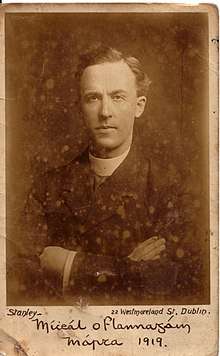
Fr. O'Flanagan was sent to Cliffoney at the end of July 1914, shortly before the start of WW1.[16] O'Flanagan, a widely travelled curate with strong nationalist, socialist and republican ideals, may have been moved by Bishop Bernard Coyne for his support of the Sligo Dock Strike in May 1913.[17] One of O'Flanagan's first initiatives was to write to Colonel Ashley of Classiebawn Castle, and he secured the old school house as a community hall for the villagers.
Upon discovering social inequity in land redistribution, he led the villagers on a campaign against the Congested Districts Board to secure rights to cut turf on the Cloonerco Bogs adjacent to Cliffoney.[18] This action, which began on 29 June 1915 became known as the Cloonerco Bog Fight.[19] The case simmered on all summer, and the villagers harvested large quantities of turf which was distributed throughout the locality. Eventually the case was settled in favour of the people of Cliffoney.[16]
O'Flanagan was invited to attend the funeral of veteran Fenian Jeremiah O'Donovan Rossa in August 1915. He gave a passionate speech at the Reception of Remains in City Hall, where he was photographed with Tom Clarke, Mary Jane and Eileen O'Donovan Rossa.[20] At the graveside O'Flanagan recited the funeral prayers in Irish before his friend Padraig Pearse made his incendiary speech.[21]
In October O'Flanagan attended a tillage meeting held in Sligo Courthouse, where T. W. Russell was campaigning on behalf of the British Government, for increased tillage production to aid the war effort.[18] When a motion to that effect was proposed, O'Flanagan objected and proposed a counter-motion, advising the people to "ignore the Board of Agriculture and adopt their own remedy...... They should 'Stick to the oats.' This call has ever since been associated with the curate of Cliffoney."
O’Flanagan’s speech ended with a rousing call: ‘The famine of 1847 would never have been written across the pages of history if the men of that day were men enough to risk death rather than part with their oat crop. Let each farmer keep at least as much oats on hand to carry himself and his family through in case of necessity till next years harvest.[16]
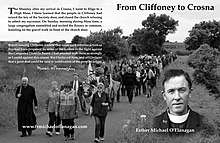
The speech was widely reported in the newspapers, and within days O'Flanagan was removed from Cliffoney by Bishop Coyne. In response, on 17 October the villagers of Cliffoney locked the door of St. Molaise's church, and refused to allow a replacement to enter, demanding instead that O'Flanagan be sent back to Cliffoney. The standoff, which became known as the "Cliffoney Rebellion" was to last for ten weeks. The people of Cliffoney knelt on the ground outside the locked church and said the Rosary for the return of O'Flanagan.[14] The villagers marched 15 miles into Sligo to have an audience with the Bishop, but he refused to meet them.[19] They also sent a petition to the Pope which was unsuccessful. Eventually the church was re-opened on Christmas Eve, 1915.[18]
An unfinished memoir, written by O'Flanagan in 1920, describes his version of the events that took place during his time in Cliffoney. The memoir was published as "From Cliffoney to Crosna" in 2016 by the Fr. O'Flanagan Memorial Group in Cliffoney.[22]
Cliffoney Volunteers
A company of Volunteers was set up in Cliffoney by Fr. O'Flanagan and Alec McCabe in 1915, were out marching in uniform for Saint Patrick's Day 1916.
In his report at the end of March the County Inspector mentioned that a branch of the Irish Volunteers had been formed at Cliffony and that other branches were in the process of being formed. He reported that the Cliffony Volunteers had paraded to the number of fifty on St. Patrick's Day wearing uniforms. They attended Mass at Cliffony and then "paraded the roads." Their leaders, William Gilmartin and Andrew Conway, carried revolvers, he reported. On the same day, he said. Alec McCabe led a parade of 69 "Sinn Féiners" in Ballymote. McCabe was reported as wearing the uniform of the Irish Volunteers and the others wearing Irish Volunteer armbands.[23]
Amenities
Cliffoney village is arranged around a cross-roads on the N15 with the church, community hall, public house and old RIC barracks each occupying a corner.
Cliffoney National school was opened in 1914, replacing the old schools built by Lord Palmerston.[24] President Michael D. Higgins visited Cliffoney National school on 22 October 2014 to commemorate the centenary of its opening.[25]
Church of St. Molaise
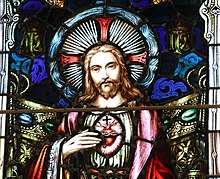
The Roman Catholic church is dedicated to Saint Molaise from Inishmurray island. The church was closed for an extensive period during restoration in 2012 when masses were held in the village hall. During cleaning the restorers discovered that the three stained glass windows behind the altar were made by Joshua Clarke, father of the stained glass artist Harry Clarke. Joshua Clarke was married to Brigid MacGonigal, a native of Cliffoney.[3]
Cliffoney Hall
The village community hall dates to 1824. The building came into the possession community in 1915 due to the work of Father Michael O'Flanagan. The building became the Cliffoney Sinn Féin club and was used for drilling by the Cliffoney Volunteers.[26] The hall was burned at the end of October 1920 during the reprisals for the Moneygold ambush.[27] It was later rebuilt and renamed the more neutral Cliffoney Parochial Hall.
The hall was renovated in 2016 with the addition of a new kitchen and restrooms. The hall is used for many community activities and fundraisers. Bingo is held every Saturday evening. The building hosts active age sessions, social dancing and dance classes, Irish dancing, guitar and martial arts classes.[28]
There are several businesses located in the village, including a hair salon, bars and restaurants, and other retail stores.[29] The Fr. Michael O'Flanagan Memorial Group hosts a traditional music session on the last Saturday of each month in O'Donnell's Bar.
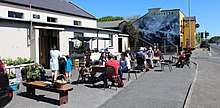
There is one shop in the village, Cliffoney Gala, which underwent a refurbishment in September 2017.[30]
Cliffoney Country Market takes place on the first and third Sunday of every month. The market sells a range of local produce and features a charity second-hand stall; local musicians provide Irish traditional music.[31]
Cliffoney Garda station was closed in early February 2013.[32] The station was handed over to the Cliffoney Development Group by Minister Brian Hayes in July 2014, with plans for the building to be used as a men's shed or tourist office.[33] However, nothing has been done with the station since that time.
Cliffoney post office was under threat of closure; however, in August 2018 after a local campaign, it was announced that it will remain open for a further three years, while 159 other post offices would shut down nationwide.[34][35][36]
References
- "Sapmap Area: Settlements Cliffoney". Census 2016. Central Statistics Office. Retrieved 7 March 2018.
- "Gazetteer of Ireland" (doc). The Placenames Commission. Retrieved 9 November 2007.
- Clarke, Joshua. "Joshua Clarke, Born: 1868ca Died: 1921". Dictionary of Irish Architects 1720 - 1940. Retrieved 28 January 2019.
- Goldbaum, Howard. "Creevykeel Court Tomb". Voices from the Dawn. Retrieved 25 January 2019.
- "St Bridget's Cross, Cliffoney". Ask About Ireland. Retrieved 25 January 2019.
- Wakeman, William (1880). "The Wakeman Drawings". Ask About Ireland. Retrieved 25 January 2019.
- White, Patrick. "St Brigid's Well". Duchas. Retrieved 26 January 2019.
- Burns, Paul. "A Mullaghmore Cromwellian". Sligo Heritage. Retrieved 25 January 2019.
- Ridley, Jasper (1970). Lord Palmerston. Book Club Associates. ISBN 978-1447244189.
- Connell, Brian (1957). Portrait of a Whig peer: compiled from the papers of the Second Viscount Palmerston, 1739-1802. Andre Deutch.
- "Classiebawn and it's owners". Mullaghmore Heritage Notes - life in a small seaside village. 1 October 2011. Retrieved 27 January 2019.
- Norton, Desmond (2006). Landlords, Tenants, Famine: The Business of an Irish Land Agency in the 1840s. University College Dublin Press. ISBN 978-1904558552.
- Norton, Desmond (2006). Landlords, Tenants, Famine: The Business of an Irish Land Agency in the 1840s. University College Dublin Press. ISBN 978-1904558552.
- Gallagher, John Joe (2013). The Way We Were - Recollections of People, Places, Events in Ahamlish Parish. Parish Pastoral Council.
- McKeon, John (2018). Lord Palmerston - An Absentee Irish Landlord. Cladac Press. ISBN 9781999999308.
- Carroll, Denis (2016). They Have Fooled You Again. The Columba Press. ISBN 978-1-78218-300-6.
- Carroll, Denis (1998). Unusual Suspects. The Columba Press. p. 206. ISBN 1-85607-239-8.
- O'Flanagan, Michael (2016). From Cliffoney to Crosna. Father O'Flanagan Memorial Group, Cliffoney.
- McGowan, Joe (2010). In the Shadow of Benbulben. Aeolus Publications. ISBN 9780952133407.
- "Studio portrait of Thomas Clarke, seated, with Mrs. Mary O'Donovan Rossa, Eileen O'Donovan Rossa and Fr. Michael O'Flanagan". National Library of Ireland. 1 August 1915. Retrieved 16 January 2019.
- Kenna, Shane (2015). Jeremiah O'Donovan Rossa: Unrepentant Fenian. Irish Academic Press. ISBN 978-1785370144.
- O'Flanagan, Michael (1920). "From Cliffoney to Crosna - an autobiography by Fr. Michael O'Flanagan". Father Michael O'Flanagan. Retrieved 31 January 2019.
- Farry, Michael (1992). Sligo 1914 - 1921: a Chronicle of Confllict. http://www.michaelfarry.com/files/sligowar.pdf: Killoran Press. ISBN 0 9520135 0 9.
- "Cliffoney National School - History of the School". Cliffoney National School. Retrieved 27 January 2019.
- Higgins, Michael D. (22 October 2014). "President visits Cliffoney National School on the occasion of their centenary celebrations". PRESIDENT OF IRELAND. Retrieved 28 January 2019.
- Farry, Michael (2012). The Irish Revolution, 1912-1923 Sligo. Four Courts Press. p. 32. ISBN 978-1-84682-302-2.
- Crowley, John (2017). Atlas of the Irish Revolution. Cork University Press. ISBN 978-1782051176.
- McHugh, Fr. Christy (25 November 2015). "Parish of Ahamlish and Inishmurray newsletter" (PDF). Parish of Ahamlish and Inishmurray. Retrieved 31 January 2019.
- "CLIFFONEY VILLAGE, COUNTY SLIGO, IRELAND". CLIFFONEY VILLAGE. Retrieved 28 January 2019.
- McCudden, Jenny (11 August 2018). "Cliffoney locals fear it will soon be a ghost village as post office under threat". The Sligo Champion. Retrieved 31 January 2019.
- "Cliffoney Country Market". Cliffoney Country Market Facebook. Retrieved 28 January 2019.
- Keaney, Harry (5 February 2013). "'Nail in the coffin' as stations close - end of long-held tradition in rural areas". The Sligo Champion. Retrieved 31 January 2019.
- Hayes, Brian (27 January 2014). "Minister Hayes Hands Over Cliffoney Former Garda Station to Local Community". Merrion Street.ie. Retrieved 28 January 2019.
- "Cliffoney Post Office in Co Sligo saved from closure". Ocean FM. 23 August 2018. Archived from the original on 24 August 2018. Retrieved 23 August 2018.
- "Locations announced of 159 post offices set to close". RTÉ News. 28 August 2018. Archived from the original on 28 August 2018. Retrieved 28 August 2018.
- "Post Office Consolidations and Nearest Alternative Post Offices" (PDF). An Post. Archived from the original (PDF) on 28 August 2018. Retrieved 28 August 2018.
